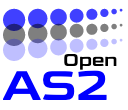The OpenAS2 application enables you to transmit and receive AS2 messages with EDI-X12, EDIFACT, XML, or binary payloads between trading partners.
There is a pom.xml in the Server folder to compile and create the jar and build the distribution package using Maven. The current version of the application is extracted from the POM and inserted into the MANIFEST.MF at build time. More detailed information is available in the DeveloperGuide.odt in the docs folder in Github.
The following commands can be used in the build process.
Checking dependency tree:
./mvnw dependency:tree
Checking dependencies against latest:
./mvnw versions:display-dependency-updates
Updating dependencies to latest:
./mvnw versions:use-latest-releases
Build a snapshot the following command should be used:
./mvnw versions:set -DnewVersion=2.12.0-SNAPSHOT
Run unit tests:
./mvnw test
Build a package
./mvnw clean package
To deploy the released artifacts requires user ID and password for Sonatype. See developer guide for details:
./mvnw clean deploy -P release - will require manual closing and release in Sonatype
./mvnw release:perform
./mvnw nexus-staging:release -Ddescription="Some release comment here"
To create the docker image, use the Dockerfile in the project. In the terminal, open the folder where the Dockerfile is located. Use commands below to login to your dockerhub account through terminal.
Run below command to create image with name and tag.
$ docker build -t openas2:latest .Run the default OpenAS2 server:
$ docker run -it --rm openas2:latestYou can test it by visiting http://container-ip:10080 in a browser or, if you need access outside the host, on port 4080:
$ docker run -it --rm -p 4080:10080 -p 4081:10081 -p 8443:8443 openas2:latestYou can then go to http://localhost:4080 or http://host-ip:4080 in a browser (noting that it will return a 401 since there are no proper AS2 headers sent by the browser by default).
The default OpenAS2 environment in the image is:
OPENAS2_BASE: /usr/local/tomcat
OPENAS2_HOME: /usr/local/tomcat
OPENAS2_TMPDIR: /usr/local/tomcat/temp
JAVA_HOME: /usr/local/openjdk-11
The configuration files are available in /opt/openas2/config/.
Build the server image:
$ docker build -t openas2:latest .Run the OpsnAS2 server, with its network set to "host", so that the WebUI can access the server.
$ docker run -it --rm --net=host -p 4080:10080 -p 4081:10081 -p 8443:8443 openas2:latestIn a separate terminal, build the WebUI docker image:
$ docker build -t openas2_webui:latest -f Dockerfile_WebUI .Run the WebUI docker image, using port 8080 on the host:
$ docker run --rm -p 8080:80 openas2_webui:latestVisit http://localhost:8080 and login with "userID" and "pWd". Note: You may have to login twice if you get a "Network Error" the first time.
Build the images:
$ docker compose buildRun the images:
$ docker compose upRun the images in the background:
$ docker compose up -dView specific container logs:
$ docker compose logs openas2
$ docker compose logs openas2_webui